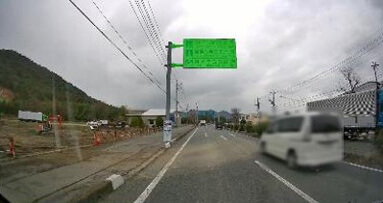Public Infrastructure Registry Management and Inspection Patrol Solutions (Audin AI)
Public Infrastructure Registry Management and Inspection Patrol Services Driven by AI Analysis Technology
We help customers implement the digitalization of preventative maintenance and daily patrol operations related to public infrastructure in order to achieve cost reductions and operational efficiency improvements.
Background
The proportion of public infrastructure built during Japan’s rapid growth period that is over 50 years old will increase rapidly over the next 20 years. As the need for preventative maintenance through prompt, adequate repairs increases, rising costs and shrinking availability of the labor pool needed for inspecting and diagnosing Japan’s extensive social infrastructure have become major issues.
-
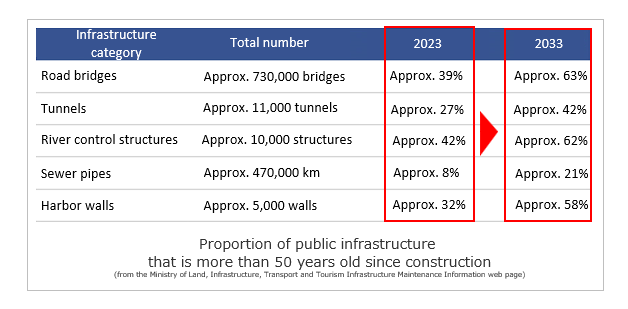
-
The aging of infrastructure is expected to rapidly worsen by 2033, and the impact on society will be significant.
It will become increasingly difficult for our society to maintain its public infrastructure under the current system.
Similarly, the communications infrastructure facilities that underpin the NTT WEST Group’s communications network were built mainly between the 1960s and the 1980s. In 20 years, 85% of these facilities will be more than 50 years old, with the aging of those facilities becoming more critical year by year. Furthermore, due to the decline in the working-age population, the number of maintenance personnel is also rapidly decreasing, making it urgent that we improve the efficiency of our infrastructure maintenance operations and establish new maintenance methods that do not require advanced skill or knowledge.
-
The NTT WEST Group believes that its diverse efforts toward digital transformation (DX) focused on achieving more efficient business operations and creating new value combined with the mutual sharing of AI technology and data assets developed through those efforts with infrastructure operators will contribute to finding solutions for broader societal issues.
-

Overview
Audin AI is a cloud service for evaluating infrastructure deterioration by combining drive recorder data with structure identification and deterioration diagnosis technology and by standardizing public infrastructure registry management and AI-based inspection accuracy.
The digitalization of infrastructure information promises to improve the efficiency of infrastructure management operations, and AI-based diagnostics can maintain and improve inspection quality.
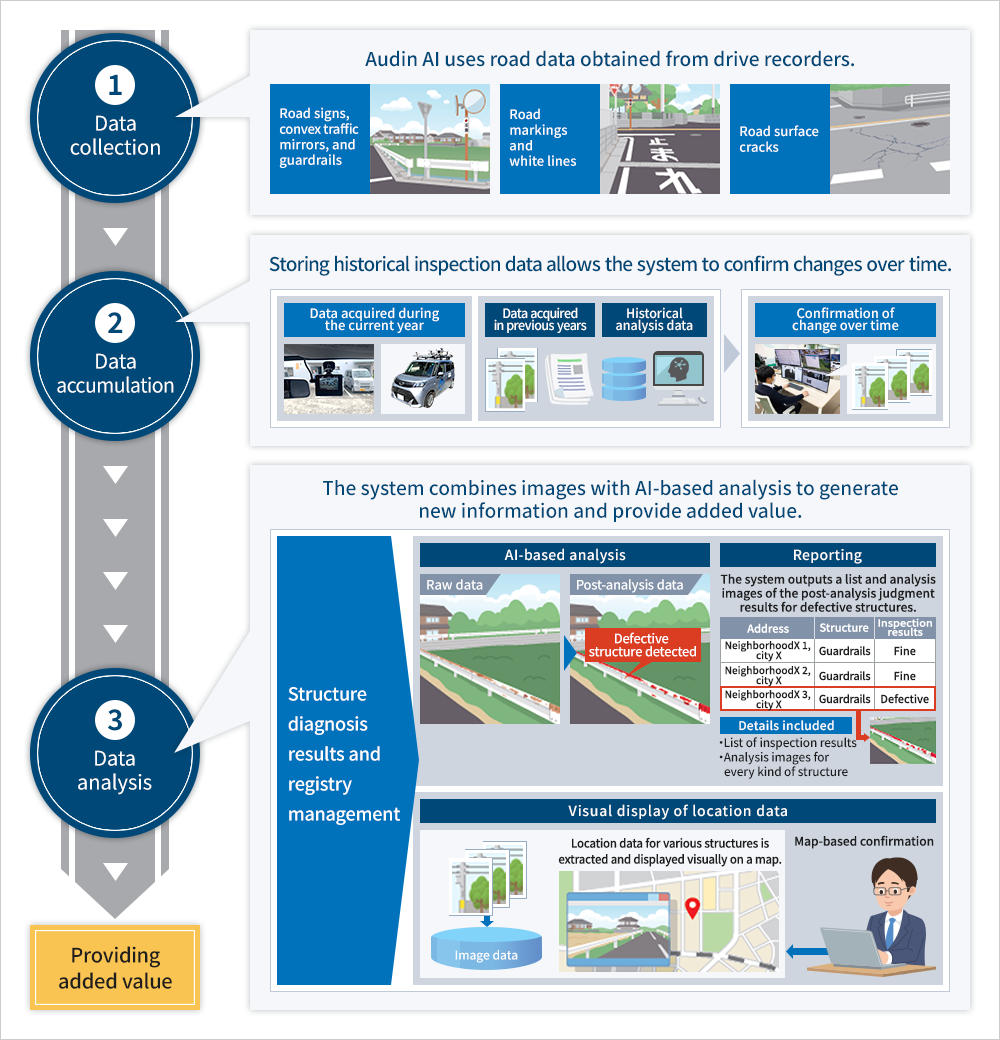
Problem-Solving
|
Anticipated problems (mainly for local government and police personnel) |
Solved by using Audin AI |
|---|---|
|
|
Visual Example
Public infrastructure image data acquired from drive recorders is combined with deterioration diagnosis AI to provide digital data for infrastructure-related structure registries and to provide reports on deterioration analysis results through a portal website.
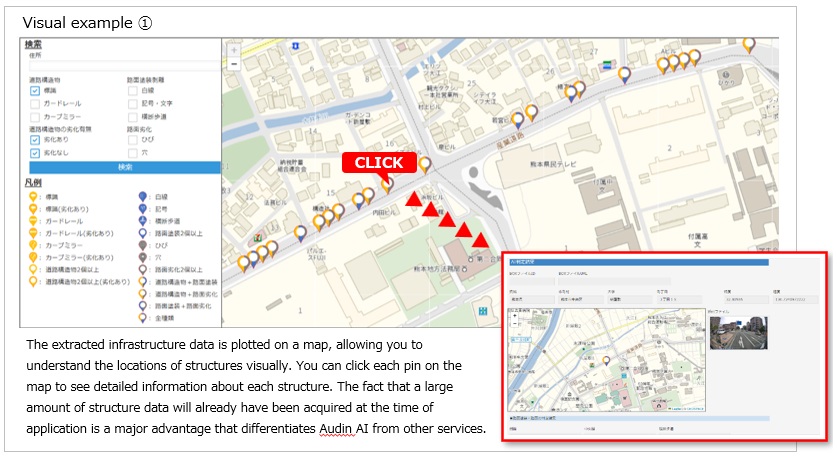
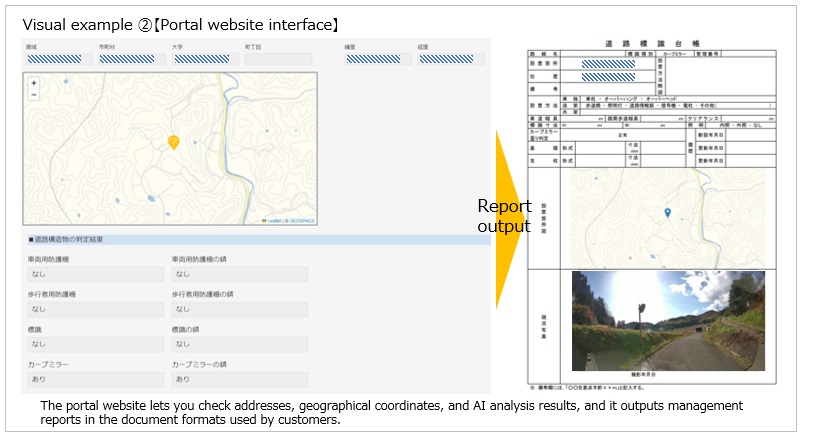
AI-Based Analysis
AI is used to analyze public infrastructure image data. By identifying road structures and diagnosing their state of deterioration, it lets you see at a glance where deterioration has occurred.

Applicable Structures
| Item | Structure category | Applicable Structures | ① Added to infrastructure registry | ②Deterioration evaluation has been carried out | Deterioration evaluation items | |
|---|---|---|---|---|---|---|
| 1 | Road structure | 1-1 | Road sign | ○ | ○ | Corrosion |
| 1-2 | Convex traffic mirror | ○ | ○ | Corrosion | ||
| 1-3 | Guardrails | ○ | ○ | Corrosion | ||
| 2 | Road surface paint | 2-1 | Road markings (symbols and lettering) | ○ | ○ | Worn |
| 2-2 | Crosswalk | ○ | ○ | Worn | ||
| 2-3 | White lines (center and road edge) | ○ | ○ | Worn | ||
| 3 | Road surface | ー | ○ | Cracks and potholes | ||
Case Studies
Adoption case study①: Registry management of convex traffic mirrors and guardrails (Fuchu, Hiroshima)
The city of Fuchu in Hiroshima Prefecture has been using Audin AI for registry management of convex traffic mirrors and guardrails.
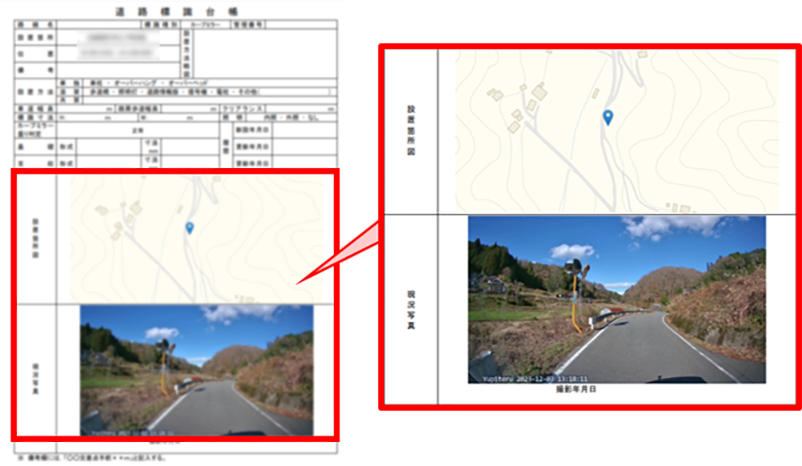
Adoption case study②: Ranked evaluation of road surface paint
Based on Audin AI reports, white lines have been classified into three ranks according to the amount of wear.
- Note: In general, self-driving vehicles are regarded as capable of handling a wear level of up to 80%, so this was used as the ranking criteria, and white lines with a rank of 3 are given priority for repairs.
| Rank | Evaluation description | Evaluation criteria | Visual depiction of paint wear rank |
|---|---|---|---|
| Rank 1 | Normal | Wear level of 10% or less | 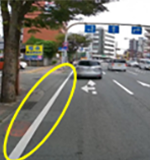 |
| Rank 2 | Medium wear level | Wear level of 11% to 79% |  |
| Rank 3 | High wear level | Wear level of 80% or higher | 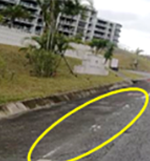 |
Adoption case study③: Updating of road sign registry
This customer used Audin AI to update its road sign registry. Not only did Audin AI add signs to the management registry that had been missing, but it was also able to detect signs that had been removed.
| Management registry | Analysis results using Audin AI (current) |
|---|---|
| ー |
|
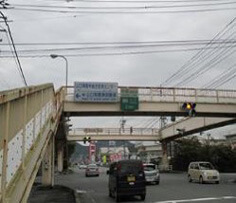
|
|
Click the button to contact us regarding this page.



